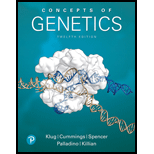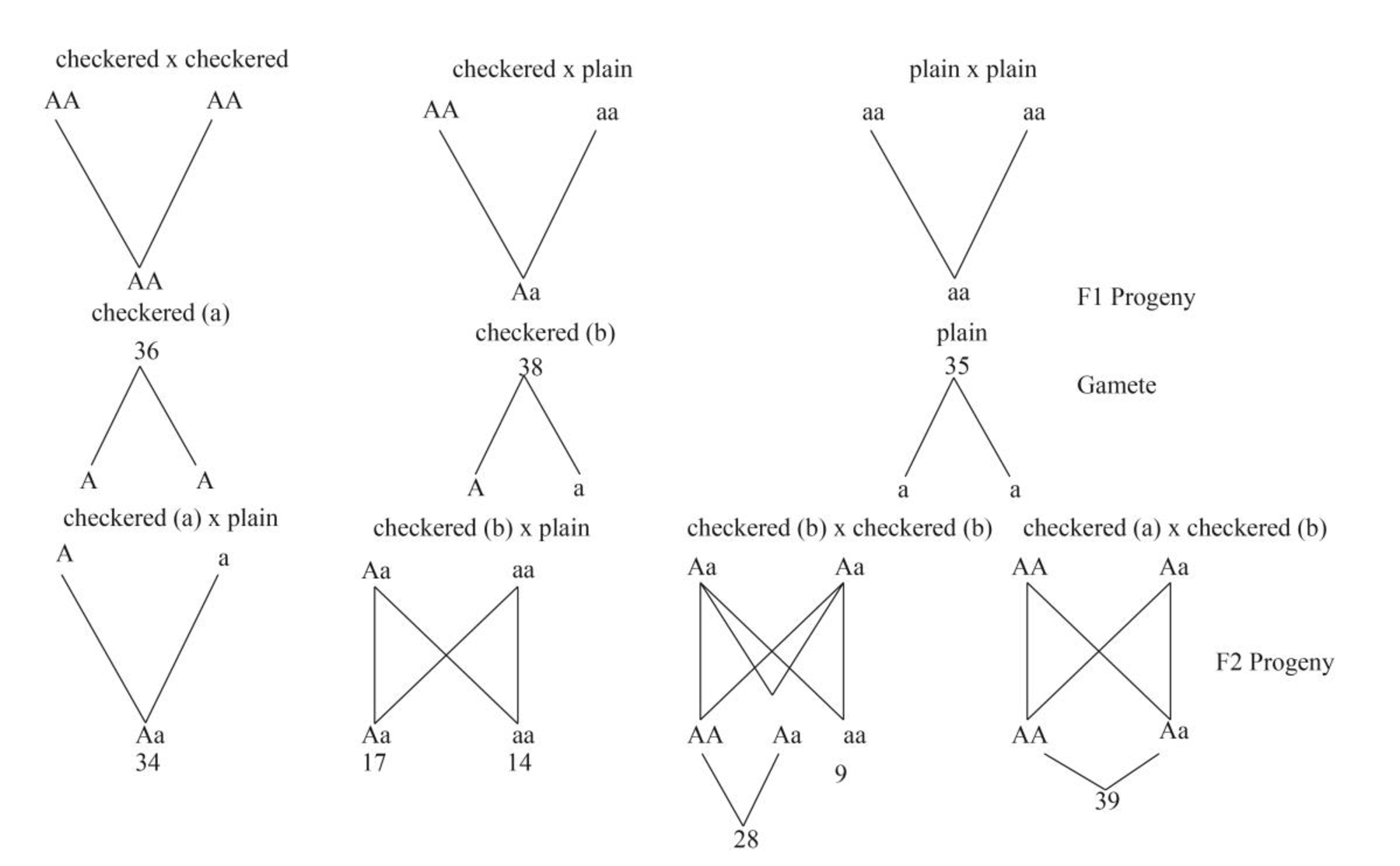
Concept explainers
Pigeons may exhibit a checkered or plain color pattern. In a series of controlled matings, the following data were obtained.

Then ⊢1 offspring were selectively mated with the following results. (The P1 cross giving rise to each ⊢1 pigeon is indicated in parentheses.)

How are the checkered and plain patterns inherited? Select and assign symbols for the genes involved, and determine the genotypes of the parents and offspring in each cross.
To determine: The pattern of inheritance of checkered and plain pattern.
Introduction: Pattern of inheritance is defined as the pattern by which a particular trait or gene is transferred to the offspring and what are the conditions that is needed for its expression. There are five different types of pattern of inheritance namely X-linked dominant, X-linked recessive, autosomal recessive, autosomal dominant and mitochondrial inheritance.
Explanation of Solution
In the cross between checked and plain pattern shows a autosomal dominance inheritance in which checkered trait is a dominant trait and plain pattern is a recessive trait. This can be concluded because in a cross between checkered and plain pattern parents give all heterozygous offspring and since checkered trait being a dominant trait is expressed in all heterozygous progeny.
The inheritance pattern of offspring produced by crossing checkered and plain pattern parents is autosomal dominance inheritance.
To determine: The pattern of inheritance of checkered and plain pattern.
Introduction: Mendel gave three important postulates by observing the monohybrid crosses and Law of dominance is one of the three laws given by Mendel. According to this law a dominant trait expresses itself in both homozygous condition as well as heterozygous condition. On the contrary, the recessive trait is able to express only in homozygous condition.
Answer to Problem 1NST
Pictorial representation: Fig.1 cross showing the F1 and F2 progeny formed after crossing between checkered and plain pigeons.

Fig.1: Crosses show the F1 and F2 progeny formed after crossing between checkered and plain pigeons.
Explanation of Solution
The dominant trait responsible for checkered pattern is represented by “A” and the recessive trait responsible for plain pattern is represented by “a”.
In the F2 cross when the F1 progeny is crossed with each other the cross between checkered (a) and plain gave 34 checkered and no plain progeny. When the checkered b progeny is crossed with the plain progeny 17 checkered and 14 plain progeny were formed. When checkered (b) is crossed with itself, 28 checkered and 9 non checkered progeny were formed and when checkered (a) and checkered (b) are crossed 39 checkered offspring’s were formed.
Want to see more full solutions like this?
Chapter 3 Solutions
Concepts of Genetics (12th Edition)
Additional Science Textbook Solutions
Genetic Analysis: An Integrated Approach (3rd Edition)
Human Anatomy & Physiology (2nd Edition)
Campbell Biology (11th Edition)
Organic Chemistry (8th Edition)
Human Physiology: An Integrated Approach (8th Edition)
Chemistry: An Introduction to General, Organic, and Biological Chemistry (13th Edition)
- If a bacterium using aerobic respiration was to degrade one small protein molecule into 8 molecules of pyruvic acid, how many ATP would that cell make? Assume there is no other carbon source. Units cannot be entered in this style of question but the units of your answer should be in molecules of ATP.arrow_forwardIf a bacterium using aerobic respiration was to degrade a 30 mM solution of citric acid, how many ATP would that cell make? Assume no other carbon source is available. Units cannot be entered in this style of question but the units of your answer should be in mM of ATP.arrow_forwardHow much ATP will be produced during the following metabolic scenario: Aerobic respiration of a 5mM lipid solution that is made up of one glycerol and an 8-carbon fatty acid and 12-carbon fatty acid. Recall that when glycerol breaks down to Glyceraldehyde-3-phosphate it costs one ATP but your get an extra FADH2. Every two carbons of a fatty acid break down to one acetyl-CoA. (pathways will be provided on the exam) Units cannot be entered in this style of question but the units of your answer should be in mM of ATP.arrow_forward
- When beta-lactamase was isolated from Staphylcoccus aureus and treated with a phosphorylating agent, only the active site, serine was phosphorylated. Additionally, the serine was found to constitute 0.35% (by weight) of this beta-lactamase enzyme. Using this, calculate the molecular weight of this enzyme and estimate the number of amino acids present in the polypeptide.arrow_forwardBased on your results from the Mannitol Salt Agar (MSA) media, which of your bacteria were mannitol fermenters and which were not mannitol fermenters?arrow_forwardhelp tutor pleasearrow_forward
- Q8. A researcher wants to study the effectiveness of a pill intended to reduce stomach heartburn in pregnant women. The researcher chooses randomly 400 women to participate in this experiment for 9 months of their pregnancy period. They all need to have the same diet. The researcher designs two groups of 200 participants: One group take the real medication intended to reduce heartburn, while the other group take placebo medication. In this study what are: Independent variable: Dependent variable: Control variable: Experimental group: " Control group: If the participants do not know who is consuming the real pills and who is consuming the sugar pills. This study is It happens that 40% of the participants do not find the treatment helpful and drop out after 6 months. The researcher throws out the data from subjects that drop out. What type of bias is there in this study? If the company who makes the medication funds this research, what type of bias might exist in this research work?arrow_forwardHow do I determine the inhertiance pattern from the pedigree diagram?arrow_forwardits an open book assignemntarrow_forward
- Describe two different gene regulation mechanisms involving methylationarrow_forwardWhat is behavioral adaptarrow_forward22. Which of the following mutant proteins is expected to have a dominant negative effect when over- expressed in normal cells? a. mutant PI3-kinase that lacks the SH2 domain but retains the kinase function b. mutant Grb2 protein that cannot bind to RTK c. mutant RTK that lacks the extracellular domain d. mutant PDK that has the PH domain but lost the kinase function e. all of the abovearrow_forward
 Biology (MindTap Course List)BiologyISBN:9781337392938Author:Eldra Solomon, Charles Martin, Diana W. Martin, Linda R. BergPublisher:Cengage Learning
Biology (MindTap Course List)BiologyISBN:9781337392938Author:Eldra Solomon, Charles Martin, Diana W. Martin, Linda R. BergPublisher:Cengage Learning Human Heredity: Principles and Issues (MindTap Co...BiologyISBN:9781305251052Author:Michael CummingsPublisher:Cengage Learning
Human Heredity: Principles and Issues (MindTap Co...BiologyISBN:9781305251052Author:Michael CummingsPublisher:Cengage Learning Concepts of BiologyBiologyISBN:9781938168116Author:Samantha Fowler, Rebecca Roush, James WisePublisher:OpenStax College
Concepts of BiologyBiologyISBN:9781938168116Author:Samantha Fowler, Rebecca Roush, James WisePublisher:OpenStax College Human Biology (MindTap Course List)BiologyISBN:9781305112100Author:Cecie Starr, Beverly McMillanPublisher:Cengage Learning
Human Biology (MindTap Course List)BiologyISBN:9781305112100Author:Cecie Starr, Beverly McMillanPublisher:Cengage Learning





